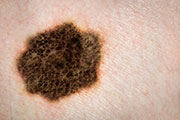NLR before initiating ipilimumab is independent prognostic indicator of poor survival
MONDAY, Sept. 21, 2015 (HealthDay News) — For patients with metastatic melanoma, neutrophil/lymphocyte ratio (NLR) before initiating ipilimumab treatment is an independent prognostic indicator of poor survival, according to a study published online Sept. 6 in the British Journal of Dermatology.
J. Zaragoza, from the Centre Hospitalier Régional Universitaire de Tours in France, and colleagues examined whether NLR measured before the first infusion correlated with overall survival in a series of 58 patients with metastatic melanoma treated with ipilimumab. The authors examined the influences of NLR and other factors on survival.
The researchers found that in univariate analysis, high NLR (≥4), high absolute neutrophil count, lactate dehydrogenase levels >2, performance status ≥2, symptomatic brain metastases, and corticosteroids before week one correlated with poorer survival. There was a significant association between high NLR and poorer survival in multivariate analysis, which remained significant after adjustment for potential confounders (hazard ratio, 1.21). NLR ≥4 was identified as an independent prognostic factor (hazard ratio, 2.2). Corticosteroid intake before week one was not identified as an independent prognostic factor.
“NLR before initiating ipilimumab treatment in patients with metastatic melanoma is an independent prognostic indicator of poor survival,” the authors write.
Copyright © 2015 HealthDay. All rights reserved.








